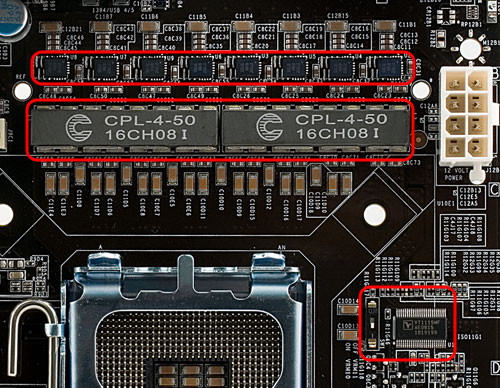This is a brief motherboard review. Moreover, it's one of the cases, when a full review with a detailed account of all features, bundled components, etc. is not necessary. That the motherboard comes from EVGA may hint that it's not a unique product. Our readers may even tell the name of the real manufacturer and designer. About half a year ago we reviewed two identical motherboards (labels, box designs, bundles) with the NVIDIA nForce 790i Ultra SLI chipset. Those models came from XFX and Zotac, so it made no sense to include the third identical model from EVGA -- our review of the reference motherboard from NVIDIA wouldn't become any better.
Nevertheless, today we are going to test an EVGA motherboard with the NVIDIA nForce 790i SLI chipset. Is this product worth examining? Yes, to some degree. The fact is, unlike other "packagers" of reference motherboards, EVGA didn't stick to a single basic model. We don't have exact information about real improvements in new EVGA products -- perhaps they are just additional modifications, offered by NVIDIA engineers to partners that sell end products. There are other possible options as well, including tech support from the OEM manufacturer. But it's not very important.
What's really important, EVGA came up with EVGA nForce 790i SLI with the "FTW" ("For The Win") suffix. This motherboard was positioned as a product that could set new overclocking records, etc. -- it's realized as the enhanced BIOS Setup, including Vdroop control. From a technical point of view, the motherboard has got an updated set of electronic components: all chokes have been replaced with shielded ferrite chokes, the board uses only polymer capacitors now (not just in CPU power circuits). Besides, the number of phases in the voltage regulator was increased from 6 to 8, so the new motherboard should really be more stable and offer a higher overclocking potential as well as energy efficiency of its onboard components. There are also several minor changes, but functionality remains practically the same. Engineers just added the second SATA-II controller to increase the number of onboard SATA ports to nine.
And now EVGA presents a new model, nForce 790i SLI FTW Digital PWM, which title indicates its only new feature: a digital PWM. There are no more differences from EVGA nForce 790i SLI FTW. However, unlike the reference motherboard with the NVIDIA nForce 790i Ultra SLI chipset, both FTW models have an important feature: they are officially based on the NVIDIA nForce 790i SLI chipset, not the Ultra version. With the insignificant difference in practical features, it means much lower costs for the chipset and the motherboard.
Design
This motherboard is equipped with three PCIEx16 slots for top SLI configurations. It's even possible to install three top graphics card from NVIDIA, although they will probably block some PCI slots. Also note the unusual and diverse locations of SATA ports. However, you won't have problems plugging cables to them.
 We marked Volterra MOSFETs, 2 Coiltronics chokes, Volterra digital PWM chip,
We marked Volterra MOSFETs, 2 Coiltronics chokes, Volterra digital PWM chip,
and the voltage control switch.
Digital PWM is not a unique solution even among desktop motherboards: for example, we examined Foxconn WinFast N570SM2AA-8EKRS2H, which was equipped with a digital PWM. Besides, this element is often used in top motherboards from DFI. And the server class of motherboards uses this component on a regular basis. Note that theoretically, a digital PWM controller has a number of advantages. First of all, it can be reprogrammed to provide a new voltage reduction range, and thus to support new processors, which require a different VRD specification. This feature is implemented here with a switch near the Volterra VT1115MF chip. Unfortunately, EVGA does not bundle its motherboards with good technical documentation. But from labels on the PCB and FAQ on the official web site we figured out that the switch sets the PWM to VRD 10 or VRD 11 modes (in simple terms, this switch chooses between Pentium 4 and Core 2 Duo processors).
For two, a digital PWM controller can work at a significantly higher frequency and supports finer adjustments as well as higher voltage stability with much lower heat dissipation. Indeed, output voltage ripple is so low that the EVGA motherboard does fine with ceramic SMD capacitors of low capacitance instead of commonplace high-capacity electrolytic models (most modern top motherboards use even solid-state polymeric capacitors). Besides, this motherboard is equipped with Coiltronics CPL-4-50 chokes (they unite four L-elements in a single low-profile package with a ferrite core). They are usually used with Volterra power modules. As a result, the processor socket is surrounded with free space (even though the board has an 8-phase VRM!) So you can install practically any cooler to enjoy the highest cooling effect.
Write a comment below. No registration needed!

